The web page of Orissa Model Tribal Education Society (OMTES) is http://www.omtes.org. Following are excerpts from its "Background" page.
The Orissa Model Tribal Education Society (OMTES), a registered Society supported by the ST & SC Development Department, aims to make positive interventions in the field of tribal education. Since its inception in March 2000, it has been instrumental in setting up 11 Ekalabya Model Residential Schools in different parts of the State with assistance from Government of India. Besides that it also manages 19 Educational Complexes set up for providing education to ST Girls belonging to Primitive Tribal Groups. OMTES continues in its endeavour to serve the tribal population of the State by ensuring them to avail best opportunities in education at par with the non tribal population.
Following are some Q & A from its FAQ page.
How the schools are managed at the district level?
A school level management committee headed by the Collector of the respective districts, members including two educationist of the area looks after the overall development of the schools. Here the collector is the chairman and concerned Principal of ERMS is the Member Secretary.
I am a Tribal, what is the benefit the society has for me?
You benefit, when your child qualifies entrance of the school and receives free qualitative education. The society provides for improving the quality of tribal by promoting educational schemes for tribal community and improves the quality of life of tribal by Ashram Schools, Hostels for Tribal Boys Educational complexes, Post- Matric Scholarships and Book Bank Schemes, etc.
Whom do I contact for more information?
For information you are requested to contact ST & SC Development, Govt. of Orissa.
The 11 schools are listed in the page http://www.omtes.org/Yearwise_establishment_EMRS.html. They are in the districts of Koraput, Mayurbhanj, Sundergarh (3), Rayagada, Koenjhar, Gajapati, Kandhamal, Nabarangpur, and Jajpur.
The 19 educational complexes are listed in the page http://www.omtes.org/Yearwise_establishment.html. They are in the districts of Keonjhar (3), Rayagada (2), Nuapara, Mayurbhanj (2), Deogarh, Angul, Kalahandi, Ganjam, Gajapati (3), Malkangiri (2), Sundergarh and Kandhamala. Each of these complexes have a capacity of 250 making a total capacity of 4750.
In contrast, as of today, KISS has a student body of 15,083, which includes 3553 students pursuing +3. KISS had a student body of 1500 in 2005. I am sure the performance of the students is better at KISS than of the students at the OMTES schools and educational complexes.
So the Odisha government should just give land, seed money and grants to KISS and let them establish and manage much larger facilities in the districts with significant tribal students.
In http://www.kiss.ac.in/admission.html it is mentioned that every year KISS gets 30,000 to 40,000 applications per year for admission and admits between 2000-3000 of them. The government should fund KISS so that if not all who apply are admitted at least half of them are admitted.
It is a pity that other states have taken note of KISS and are inviting KISS to open replicas in their states while Odisha does not seem to be taking similar steps. Following is an excerpt from a report in Pioneer on other states approaching KISS for replicas.
A branch of the Kalinga Institute of Social Sciences (KISS) has been set up in Bastar, a tribal dominated and Maoist infested region of Chhattisgarh with assistance from the National Mineral Development Corporation (NMDC).
An MoU to this effect was signed between the KIIT and the KISS founder Dr Achyuta Samanta and NMDC director GB Joshi in the presence of the NMDC chairman cum managing director Rana Som at the the latter’s Corporate Office in Hyderabad on June 24.
As per the agreement, the NMDC has provided 30 acres of land along with all financial assistance to the KISS in order to set up its replica in Kankar region of north Bastar district in Chhattisgarh. In the first phase, 1000 tribal boys and girls will be admitted in this school. However, a total of 4,000 students from five districts in and around Bastar will get the opportunity of quality education here in course of time.
After Bastar, the Governments of Jharkhand, Madhya Pradesh and Delhi are keen to set up such model schools bearing all financial implications. They have requested Dr Samanta accordingly.
The page http://www.kiss.ac.in/fmngt.html explains how KISS is funded. The total amount there adds up to 18 crores. If 10 such KISS replicas are established in 10 tribal districts of Odisha at an additional cost of 200 crores/year, that will be the best use of such money for Odisha.
July 8th, 2011
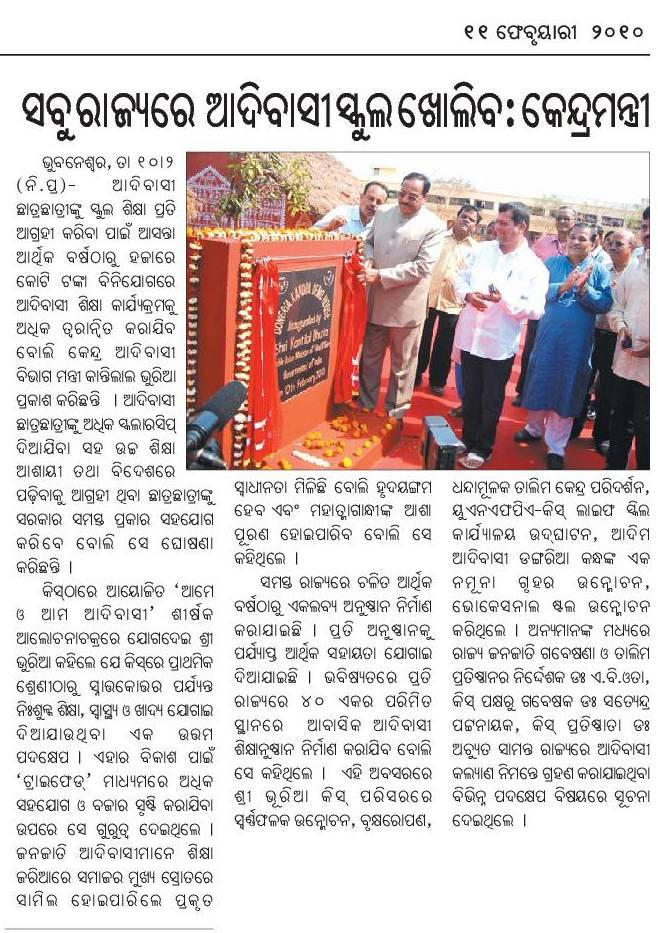
February 11th, 2010
Update: As per another report in tathya.in the Odisha ST & SC development department plans to also support SC and ST students joining Sainik School. Another great move by the department and its visionary secretary Ashok Tripathy.
Following is an excerpt from a report in Pioneer.
… The Department of ST & SC Development has set in motion a pioneering proposal to help out the bright students of the ST and SC categories.
… it is proposed to select at least 100 students from the ST and SC communities strictly on merit to reimburse their entire expenditures for studying in the best schools of the State from Classes-I to XII, said an official.
There are a number of residential schools of international standard in the State. Leading the list are Sai International, KIIT International, DPS, Phulnakhara, DPS, Damanjodi, DPS, Angul, DAV Public School at Unit VIII, Bhubaneswar.
… The students selected for admission will be provided tool kits and proper baggage so that they will not feel inferior to their affluent classmates. They will be provided to-and-fro journey expenses from the schools to their native places during holidays.
It should be noted that the RTE bill and its draft rules requires something similar. But kudos are due to the Odisha SC & ST department and its secretary Ashok Tripathy for taking proactive steps and having it implemented early in Odisha.
February 11th, 2010
Thanks to kalahandia.blogspot.com for the pointer. Following is an excerpt from a report in indiaedunews.
… the country could soon have a new model of central universities that offer preferential admission to students from minority communities which is not followed by any central varsity until now.
The proposal forwarded to the law Ministry for inspection explores a central university model in public-private partnership mode (instead of total central funding), to come up on land donated by the Wakf Board in Rajasthan, Bihar and Karnataka.
Although offering admissions to both majority and minority students, the land for these universities will be given by the Musilm communities with the minorities getting the maximum share of seats.
They are expected to come up at Ajmer, Kishanganj and Mysore and are expected to get the maximum share of seats in these new varsities.
The Minister of Minority Affairs Salman Khursheed confirmed that the concept has been borrowed from Dr B.R Ambedkar University, which came up to educationally empower SC students.
Odisha must take a cue and push for PPP based central universities – in addition to branch(es) of IGNTU – for its tribals.
January 18th, 2010
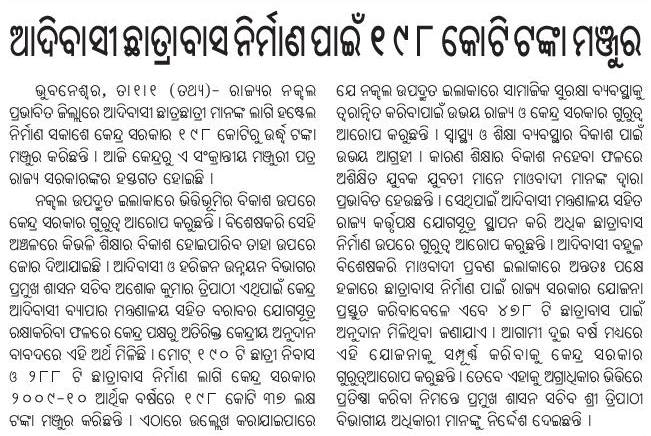
January 2nd, 2010
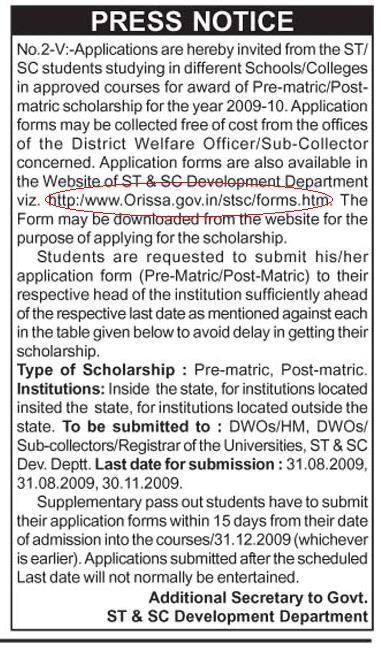
May 13th, 2009
The following is from Samaja.
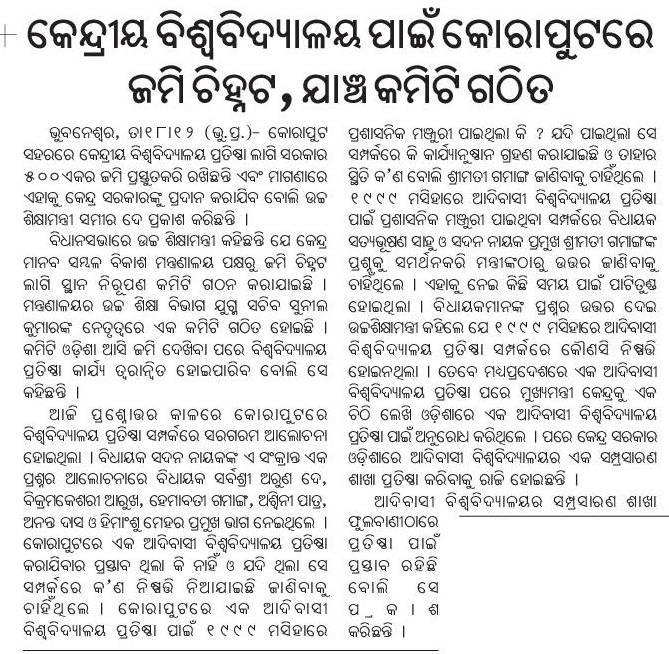
It is high time people of Kalahandi go to the CM for higher education institutes in Kalahandi. In particular they should demand a state university and a centrally funded BPIET (Biju Patnaik Inst of Engineering and Technology) in the line of SLIET and ABA Ghani Khan Choudhury IET. The people of Kalahandi need to be strategic in terms of what they can get at this time. For example, UCE Burla supporters initially, for several years, were going after a deemed university status. It was going very slowly. Once they switched to demanding for state unitary university status, things happened fast. Similarly, people of Kalahandi should realize that they should not put all their egg in one basket. IMHO, shifting of the location from Koraput to Kalahandi after the location is announced by the CM and mentioned in the assembly is unlikely, and I hope I am wrong, but a new central university in Kalahandi has a low chance of happening soon. So as a practical matter people of Kalahandi should, for now, ask for a state university and a BPIET. They don’t have to retract their demand for a central university; that can continue.
December 19th, 2008
Besides IITs and NITs some centrally funded engineering colleges are being established by the central govt. in various states. This includes the Sant Longowal Institute of Engineering and Technology in Punjab and Central Institute of Technology, Kokrajhar, Assam.
Following is a PIB report on a similar institute being established in Malda, West Bengal.
The Union Cabinet today gave its approval for establishment of Ghani Khan Choudhary Institute of Engineering & Technology, as a Centrally funded institution in Malda, West Bengal on the modular pattern of teaching as adopted by Sant Longowal Institute of Engineering & Technology (SLIET), Longowal, Punjab. The Institution will offer courses in Engineering and Technology to cater to the various manpower requirements of the region, with special emphasis on courses relevant to the local population such as in food technology & sericulture.
Initially, the Institution would start with Certificate level courses leading to Diploma, Degree and Post-graduate levels later.
The total project outlay of the Institute will be around Rs. 97 crores.
Orissa should ask for a similar engineering college to cater to the backward KBK+ districts and located in Kalahandi.
Koraput will have the central university; Branch of IGNTU is being pursued in Kandhamala. So an engineering college like SLIET should be located in Kalahandi. The institute can be called KBK institute of Engineering and Technology (KBKIET).
November 20th, 2008
Update: Pioneer reported on this; Expressbuzz.com reported on this; Zee news reported on this.
Following is an excerpt from a PTI report in Hindu:
Orissa government has asked the Centre to adopt a long term plan for Kandhamal, prone to ethno-communal violence instead of seeking any quick solution, official sources said on Tuesday.
Orissa’s suggestion came after the high-level central team headed by Union Agriculture Minister Sharad Pawar, which visited Kandhamal today, sought to know what assistance was needed in mitigating the problems there.
"The Centre wants to support Orissa in building confidence among all sections of the people in Kandhamal," Pawar told reporters after the team arrived here yesterday.
Identifying backwardness in education, lack of connectivity and poor livelihood means as the cause behind the ethno-communal violence in Kandhamal, Orissa government asked the Centre to set up a campus of the National Tribal University, Amarkantak at Phulbani, the district headquarter town.
"As scheduled tribes constitute 52 per cent of Kandhamal’s population, it is proposed to have one Ekalavya model residential school (EMRS) in each block to cater to the needs of tribal children," …
This apart, the state government also asked for at least six schedule caste hostels to cater the children of SCs who comprise 17 per cent of the total population in the district . ..
Following is from a report in tathya.in.
Naveen Patnaik has demanded for a Regional Centre of Indira Gandhi National Tribal University (IGNTU) in Kandhamal.
Presenting the memorandum to the Central Ministerial Team headed by Sharad Pawar, the Chief Minister pleaded for the Centre of Higher Learning in the riot –hit tribal zone.
… He said it will go a long way to provide education to the tribal youth, who are in difficult situation.
Following is from Sambada. It mentions the demand for an ICAR lab.
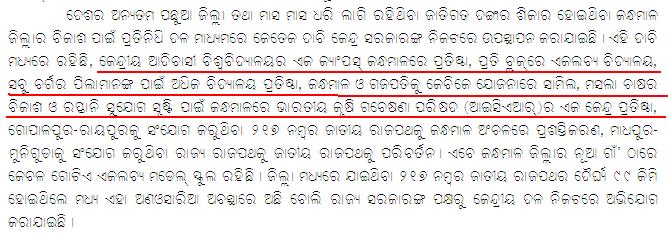
November 18th, 2008
Following is from a PTI report.
Tue-Sep 16, 2008
New Delhi / Press Trust of India
The first tribal university of the country, which aims at promoting higher education among the Scheduled Tribes, has started functioning from this session in Amarkantak in Madhya Pradesh but sans teachers and a campus of its own.
Indira Gandhi National Tribal University (IGNTU), the first of its kind dedicated for education and research on tribals, has given admission to 150 students this year. It will offer courses in humanities and commerce.
"We have given admission to about 150 students, including 100 belonging to tribal communities. We are offering Bachelor Degree programmes in anthropology, tourism, political science, geography, history and commerce," IGNTU Vice-Chancellor C D Singh told PTI.
The university, which is yet to have its own Academic Council, has adopted the syllabus of Banaras Hindu University (BHU) for the courses.
HRD Minister Arjun Singh had laid the foundation of the university at Amarkantak on April 19 this year. However, the land is yet to be acquired for its campus.
"We have hired a building of an Ashram in Amarkantak where we will conduct classes. Hope we will get the land soon from the state government," the Vice-Chancellor said.
A major portion of the land earmarked for the campus comes under forest area. It has not been transferred to the university till date.
The university has started the process of recruiting its registrar and teaching faculty.
The courses on anthropology and tourism will touch upon the tribals’ tradition and culture, he said.
"We will start research on tribal art, culture, tradition, language, custom, medicinal system, forest-based economic activities including special studies in flora and fauna and advancement in technologies relating to natural resources of tribal areas. All these will start after we get the campus and adequate staff," the Vice-Chancellor said.
The university, set up under a Central law enacted last year, will have jurisdiction all over the country and will be funded by the University Grants Commission.
The education of the tribal people has been a matter of concern in view of low gross enrolment ratio (GER), the percentage of people of the relevant age group in the realm of higher education. While the national GER is 11.6 percent, the GER of the tribals is a meagre 6.6 percent.
The university, which will be broadly on the pattern of existing Central universities, will cater particularly to the tribal people in Madhya Pradesh, Orissa, Chhattisgarh, Jharkhand, Andhra Pradesh, Maharashtra, Rajasthan and Gujarat, he said.
Besides headquarters at Amarkantak, the university will have regional centres and campuses in other tribal concentrated areas, the Vice-Chancellor said.
Authorities of the university like executive council, academic council, college development council, boards of studies, academic boards, management boards and finance committees will have adequate number of members from among the Scheduled Tribes, he said.
Amarkantak has been selected as the site for the university because it is a central point in the tribal areas stretching between Madhya Pradesh, Chhattishgarh, Jharkhand and Maharashtra.
November 16th, 2008
Following is an excerpt from a report in e-pao.net.
New Delhi, November 11 2008:
STATE CHIEF Minister Okram Ibobi along with the Education Minister L Jayantakumar and the Tribal Development Minister DD Thaisii met Prime Minister Dr Manmohan Singh at the Prime Minister’s Office here this afternoon in connection with the reservation policy for recruitment of scheduled tribes in Manipur University and opening of a regional centre of the Indira Gandhi National Tribal University in Manipur.
During the half an hour meeting, Chief Minister Ibobi told the Prime Minister that the Manipur University, which was a State University , became a Central University in the year 2005.The All Tribal Students’ Union of Manipur (ATSUM) and Manipur University Tribal Students’ Union (MUTSU) had been requesting the Central Government as well as the State Government seeking adoption of the State Government’s reservation policy in matters of recruitment in the Manipur University.
The Chief Minister further stated that based on the population composition of Manipur, the reservation policy of the State Government stipulated 31 pc reservation for Scheduled Tribes and 2 pc for the Scheduled Castes, as against 7.5 pc for Scheduled Tribes and 15 pc for Scheduled Castes in the Central Reservation Policy.
As such, the State Government had recommended to the Central Government the adoption of the State Reservation Policy by the Manipur University as a special dispensation keeping in view of the ethnic composition of Manipur.
O Ibobi also referred to the establishment of the Indira Gandhi National Tribal University at Amarkantak in Madhya Pradesh by a Central Act namely the Indira Gandhi National Tribal University Act 2007.This Act empowered the University to make special provisions for the employment or admission of women, persons with disabilities or of persons belonging to the weaker sections of the society and, in particular, of the Scheduled Castes and scheduled Tribes.
The Chief Minister further expressed that Manipur had nine districts; out of which five districts were predominantly inhabited by the tribal communities.
The facilities for imparting education in hill districts were inadequate.
It would help a great deal in promoting education among the tribal communities of the State, if a Regional Centre of the Indira Gandhi National Tribal University had been established in one of the hill districts of Manipur.
He demanded for setting up a Centre of the Indira Gandhi National Tribal University in one of the hill districts of Manipur.
After patient hearing, the Prime Minister Dr Manmohan Singh expressed that the rectification of the Central Reservation Policy required an amendment of the policy and it would take time.
But the Centre would see the possible way to rectify it.
In regards to the opening of a Regional Centre of the Indira Gandhi National Tribal University in Manipur, the Prime Minister nodded enthusiastically at the proposal.
He advised the Union Secretary of Higher Education Shri Rameshwar Pal Agrawal who was also in the meeting asked to sit with the Ministers from Manipur tomorrow at 4 pm for working out the modality for opening of the Centre in Manipur.
Tomorrow, the Manipur Education minister Shri L.Jayantakumar Singh and the Tribal Development Minister Shri D.D.Thaisii will sit with the Union Secretary (Higher Education) Shri R.P.Agrawal at Shastri Bhavan here to chalk out the modality for opening of the Regional Centre of the Indira Gandhi National Tribal University in one of the hill districts of Manipur.
Following is an excerpt from the report in e-pao.net on the follow-up meeting.
November 13 2008: STATE CHIEF Minister Okram Ibobi and the Education Minister L Jayantakumar on Wednesday met the Union Minister for Human Resources Development Arjun Singh at Shastri Bhawan here to relay the assurance of the Prime Minister of India Dr Manmohan Singh made on the previous day for opening of the Manipur campus of the Indira Gandhi National Tribal University.
The meeting lasted for about 10 minutes.
In the afternoon at 4 pm on Wednesday at Shastri Bhawan here; the Manipur Education Minister L Jayantakumar, Tribal Development Minister DD Thaisii and students leaders had an hour long discussion with the Union Secretary (Higher Education) RP Agrawal assisted by two Joint Secretaries for formulation of the proposed Manipur campus of the Indira Gandhi National Tribal University, Amarkantak in Madhya Pradesh.
The Union Secretary (Higher Education) informed the Manipur Ministers that the matter regarding the opening of a Regional Centre of the University in Manipur had been communicated to the Vice Chancellor of the University.
An expert group consisting of the representatives of Jawaharlal Nehru University, Delhi and Indian Institute of Technology, Delhi had been formed for preparation of Detailed Project Reports of the proposed Centre in Manipur.
RP Agrawal also communicated to them for sending a high level team comprising of representatives from the Ministry of Human Resource Development and the Indira Gandhi National Tribal University to Manipur very soon to see the suitable location of the Centre.
The Secretary asked the Manipur representatives to find out a suitable location of the area of 500 to 700 acres.
He informed them that the appointment of faculty staff of the Centre would be done on the basis of the all-India norm and as for the admission of the students; it would be based on the ethnic composition of the State.
… The Manipur Tribal Development Minister DD Thaisii said here today that the opening of the regional centre of the Indira Gandhi National Tribal University would have a good opportunity not only for the tribal people of the region but also for the general people in learning different subjects in the University.
The Minister further stated that the proposed regional centre in Manipur would be the first campus of the University.
The Union Secretary told them that the Ministry received many proposals from different States for opening of the branches of the University in their respective States, he added.
Why is not Orissa proposing one such regional center in one of its tribal districts? At the current moment Kandhamala would be an easy sell.
November 14th, 2008
Following is from http://pib.nic.in/release/release.asp?relid=43337.
The Cabinet Committee on Economic Affairs today gave its approval for a revised centrally sponsored scheme for construction and running of girls’ hostels for students of secondary and higher secondary schools in each of the educationally backward block during the 11th Five year Plan. The CCEA also gave its approval to incur and expenditure of Rs.2000 crore as Central share with a sharing pattern of 90:10 between the Centre and the States. The revised scheme provides for construction of 3500 hostels through State Governments in all the educationally backward blocks in the country in addition to recurring grant to meet the need of inmates.
October 3rd, 2008
The expert committee report is at http://www.ugc.ac.in/notices/dpr374modelcolleges.html. The list of 374 districts contains 18 districts from Orissa. They are: Malkangiri, Baudh, Kandhamal, Nuapada, Nabrangpur, Gajapati, Koraput, Sonapur, Bargarh, Deogarh, Kalahandi, Balangir, Anugul, Rayagada, Kendujhar, Ganjam, Nayagarh, Dhenkanal. Of these, Malkangiri and Baudha are in Phase 1 with CPI (colleges per lakh population) below 4, Kandhamal and Nuapada in Phase 2 with CPI 4 to 8, and the rest in Phase 3 with CPI 8.1-12.4.
Following are some excerpts from that report:
The criteria for identification of location within the district may be the following:
a. The college has to be located in an area of the district having no college in the vicinity of 10 km radius.
b. Predominantly rural location where the proportion of rural population in area is higher than the State average
c. A new college as an additional one in the vicinity shall be permitted only if the existing college has more than 1000 students, or there is no separate college for women in the area of 10 km. radius.
d. Accessibility : The location of the college should be such that it is accessible, i.e. reasonably well connected by transport facilities so that the college may serve a larger catchments area.
e. Population density: The proposed college should be located subject to fulfillment of the above-mentioned criteria in locations having higher population density in comparison with other contending locations.
4.1. Non- recurring Budget requirements:
4..1.1. Land : Since the Model colleges are to be established in rural, hilly, forest, tribal and other priority areas as per the criteria already described in chapter.2., a minimum of 10 acres of land need to be provided by the State Government concerned to each of the college in the identified low GER district.
4.1.2. Non recurring infrastructure requirements per college:
4.1.2.1. Academic & administrative buildings (3000 sq.mtrs) : 2.5 crores
4.1.2.2. Campus development : 2.0 crores
4.1.2.3. Hostels for 100 students : 1.0 crores*
4.1.2.4.Teachers’/Non teaching quarters – 20 each; : 2.5 crores
4.1.2.5. Laboratories : 0.2 crore
4.1.2.6. Library : 0.2 crore
4.1.2.7. Computer Centre : 0.2 crore
4.1.2.8. Health centre : 0.1 crore
4.1.2.9. sports facilities : 0.1 crore
4.1.2.10 Miscellaneous : 0.2 crore
Total per College Non-recurring :9.0 Crores.
* the expenditure towards hostel could be sanctioned through the UGC special scheme for “ hostels”. The net Non-recurring requirements would thus be Rs.8.0. crores per college.
4.1.2. Recurring Budget requirement: It would involve the salary requirements for 25 teaching and 25 nonteaching personnel for each college and the college maintenance expenditure of Rs.50.0 lakhs per annum to be provided by the State government concerned.
4.1.4.1. Model I: Fully Government supported Colleges:
Non-Recurring : 100 % by Central Government, while the required land for the colleges has to be provided by the State Govt.
(This pattern of financial support by Central Govt. is necessary to motivate the State Governments to
establish these model colleges in the Low GER districts adhering to the criteria suggested for actual location of these Colleges within the LOW GER districts) Recurring : 100% by the State Government;
September 7th, 2008
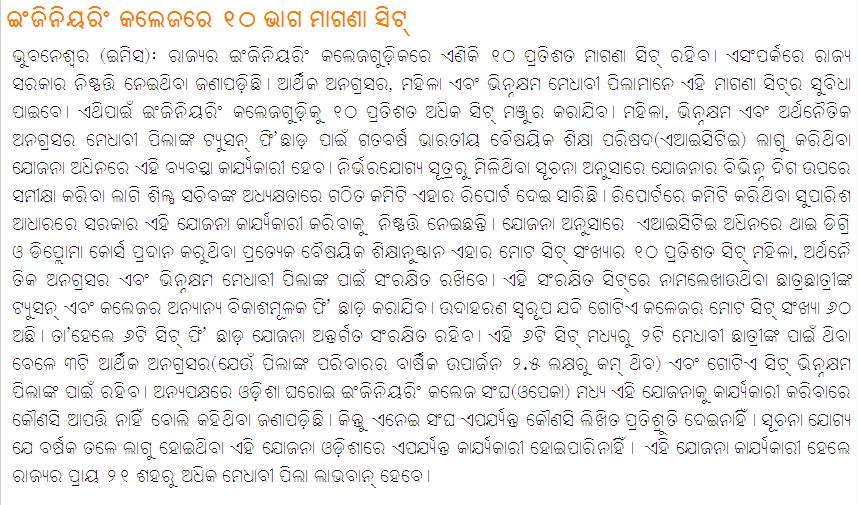
July 15th, 2008
Following is from the PIB release http://pib.nic.in/release/release.asp?relid=39900.
The Ministry of Tribal Affairs had decided to set up three apex tribal research institutes for undertaking research on ground and to suggest application oriented projects for tribal development. These institutes to be set up at Orissa, Maharashtra and Madhya Pradesh will also suggest action plans for the promotion of culture and language of tribal communities, conduct research and evaluation studies. Briefing the Members of the Parliamentary Consultative Committee attached to his Ministry here today, Shri P.R. Kyndiah, Minister for Tribal Affairs said that his Ministry is actively considering 100% Central government’s funding for setting up these institutes.
Highlighting his Ministry’s initiatives for tribal welfare, Shri Kyndiah said efforts were being made to reorient the functioning of the 18 tribal research institutes already working in the various parts of the country. Now onwards, only those research studies would be allowed at these centres, which would have direct impact on the life of tribals. The institutes would also be asked to suggest activities creating economic opportunities direct or indirect for the tribals. Experts would be involved to suggest projects to promote traditional art and craft of tribals.
Participating in the discussion, Shri Rameshwar Oraon, Minister of State for Tribal Affairs stressed the need for strengthening existing tribal research institutes, he said that these institutes should work in fields to study tribal issues closely and suggest effective measures for inclusion in Government’s programmes and policies. He said that libraries at these centers to be strengthened to provide rich study material for research in tribal related issues.
Participating in the meeting, Members of the Parliamentary Consultative Committee were of the view that Tribal Research Institutes should open their branches in tribal dominated pockets and their activities should be linked with the practical projects for economic and social development of the tribal people. Members also suggested there should be strict monitoring to see whether tribal welfare funds were being used genuinely. They also suggested speedy implementation of the Forest Rights Act. The meeting was attended by S/Shri Giridhar Gamang, Baliram Kashyap, Baju Ban Riyan, Rajesh Kumar Manjhi and V. Kishore Chandra S. Deo (all Members of Parliament).
NCJ/DT
June 30th, 2008
Following is from http://www.dte.org.in/download%5CFee_Waiver_Scheme_AICTE.pdf. I hope the private and the government colleges adopt this scheme, at least in phases. Perhaps new private colleges need not have it for the first three years. Existing colleges could do it in two steps; start with 5% this year and then increase it to 10% in the next year.
No. 37-03/Legal/2007
ALL INDIA COUNCIL FOR TECHNICAL EDUCATION
NEW DELHI
Guidelines
Date: 09-04-2007
Sub: Scheme on Tuition Fee Waiver scheme for women, economically backward and physically handicapped meritorious students.
The AICTE has been empowered under Section 10(e) of AICTE Act to formulate schemes for promoting technical education for women, handicapped and weaker sections of the society. In compliance with these provisions under the AICTE Act, it has been decided to introduce Tuition Fee Waiver scheme for women, economically backward and physically handicapped meritorious students in technical institutions.
I-Applicability:
The proposed scheme shall be applicable to the Students of all AICTE approved technical Institutions offering;
a) Bachelors programmes in Engineering, Pharmacy, HMCT, Architecture and Applied Arts and Crafts.
b) Diploma Programmes of three years duration in all disciplines.
The Scheme is proposed initially for Under-graduate and Diploma Programmes. The scheme will be voluntary in nature.
II-Purpose:
The scheme is proposed to provide Tuition Fee Waiver to women, economically backward and physically handicapped meritorious students pursuing degree/diploma level technical education covering degree programmes in Engineering & Technology, HMCT, Pharmacy, Architecture, Applied Arts and Crafts and Diploma Programmes in the above disciplines.
III-Amount of waiver:
The Waiver is limited to the tuition fee as approved by the State Level Fee Committee for self-financing institutions and by the Government for the Govt. and Govt. Aided Institutions. All other Fee except tuition fees have to be paid by the beneficiary.
IV-Method of implementation:
Under the Scheme, the Competent Authority for admissions shall be the same as for regular admissions. And Institutions shall provide tuition fee waiver up to 10 percent of its sanctioned intake of students. Typically for every 60 sanctioned intake in a branch/discipline of study, tuition fee waiver shall be given to two woman candidates, three economically weaker students (Annual income of Parents/Guardians less than Rs. 2.50 lakhs from all sources) and one physically handicapped students based on merit. In the event of non-availability of students in a specific category as above, the benefit will be given to any other candidate of other categories according to merit. An award letter is this respect shall be issued by the respective Institution with the approval of the Competent Authority for admissions.
The Institution in turn shall be allowed to admit 10% of its sanctioned intake or the number of actual tuition fee waiver granted by the Institution, whichever is lower, as an additional intake in the same discipline/branch of study.
Incase of Government/Govt. aided Institutions this additional intake may be on self-financing basis, if they so desire.
1 The AICTE approved technical institutions shall inform the number of the tuition fee waivers, branch wise to the admission authorities of the concerned state and give an undertaking that the institution will not charge tuition fee for the duration of the course form the beneficiaries.
2 The State Govts. Affiliating Universities of the concerned state shall allow equal number of seats over and above the present sanctioned strength subject to maximum of 10% of the approved intake in the same branch in lieu of the Tuition Fee Waivers. Private Institutions shall be allowed to admit students to the tune of the number of Tuition Fee waivers actually awarded from the same merit list as intake over and above the present sanctioned strength. Similarly the Government Institutions may fill up these additional seats on merit basis and if desired on self financing basis with the approval of the State Government.
3 The Institution shall admit students against these seats as per the procedure followed for admitting the regular seats at Institution level by the State admission authority. The list of students admitted in this category shall be displayed in the Notice Board of the Institution and its web-site along with the list of students given tuition fee waiver.
4 The State Govts. shall include the names of the institutions who have volunteered to avail the scheme with details of tuition fee waivers available in each institution branch wise in the admission brochure and publish the same for the benefit of the students.
5 The Institutions have to publish in their brochure and website the number of tuition fee waivers available in each category (Woman, economically weaker and physically handicapped) of students in each discipline.
6 The Competent Authority for admission shall have to display Tuition Fee Waiver status against each Institution, branch wise, to the candidates during the counseling, during admission and at the end of admission process so that the students can freely exercise their informed choice.
7 The information on availability of tuition fee waiver scheme shall be provided to the candidates, institution wise and discipline wise through Information brochure, Counseling brochure and website etc. The selection of candidates for tuition fee waiver shall be decided during the Counseling based on merit from amongst the eligible candidates. An eligible candidate shall have an option to exercise his/her choice of Institutions and discipline of study during Counseling for availing benefits of the scheme.
8. The Institutions shall provide the following information to the AICTE, concerned State Govt. and affiliating University:
Particulars of each beneficiary including name and rank of the students who have been granted tuition fee waiver in each discipline/branch of study, and
Details of the students admitted against the additional seats including name and rank etc., according to merit prescribed for regular admission.
The Institutions shall also display such information in their websites for information to the students and other stake holders.
9. The tuition fee waiver to a student shall be for the duration of the course i.e. four years for Bachelor courses in Engineering & Technology, Pharmacy, HMCT and Applied Arts and Crafts, and three years for Diploma students and five years for B. Arch course. Once a student is given Tuition Fee Waiver, the same shall be continued for the normal course duration.
(Dr. K. Narayana Rao) Member Secretary
*****
June 27th, 2008
Previous Posts





